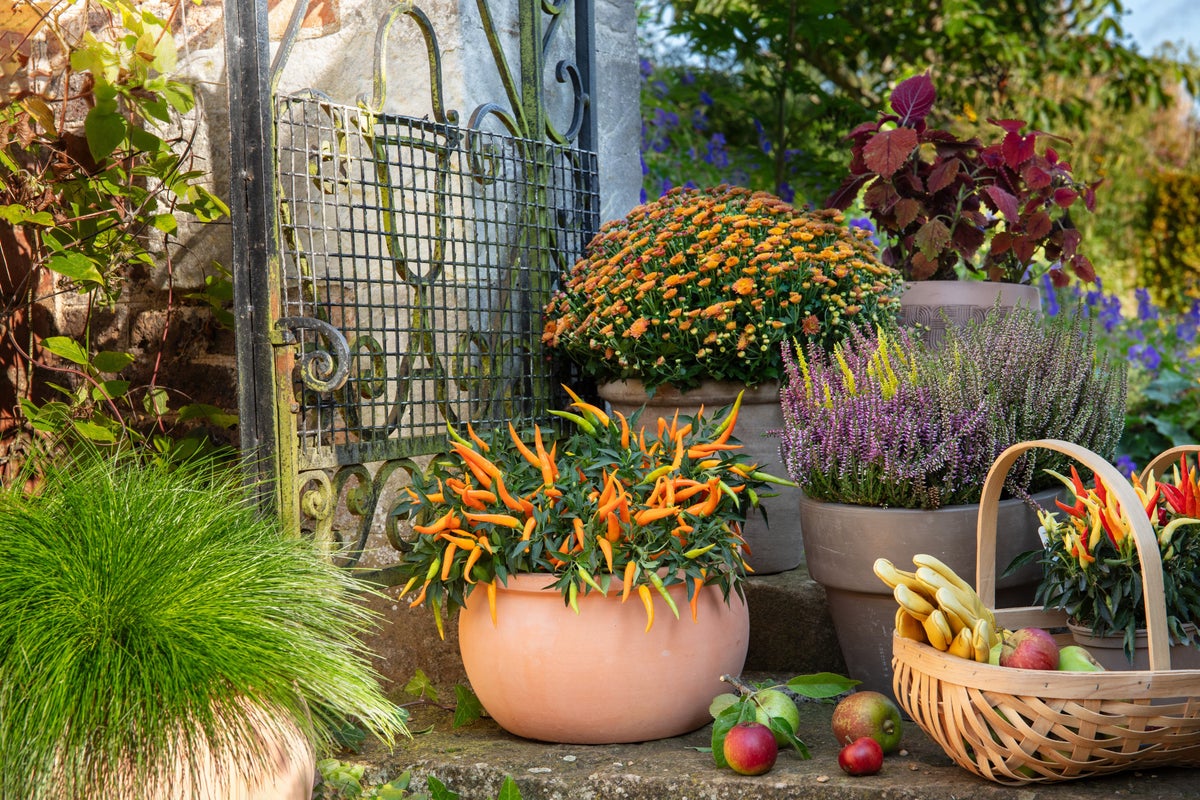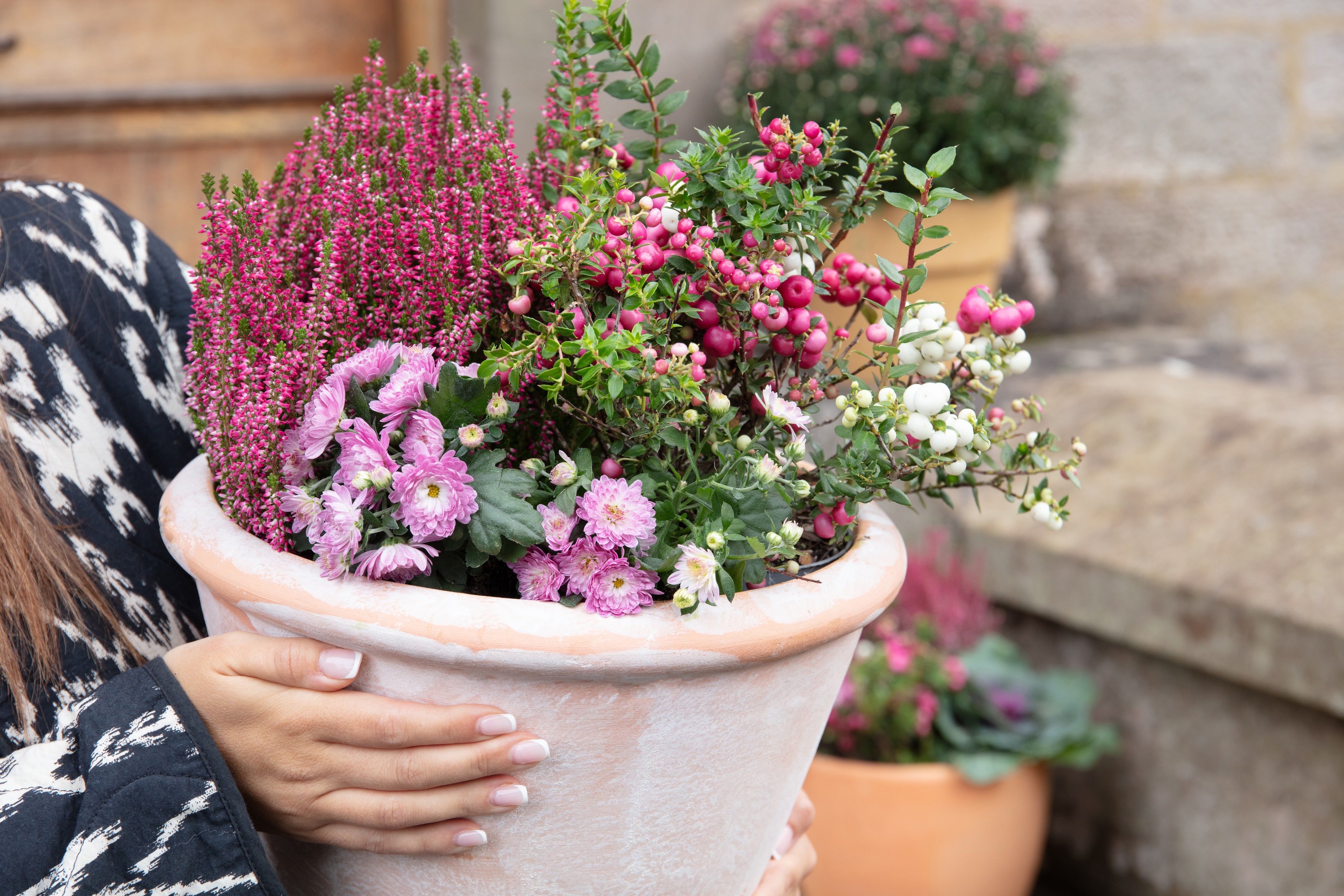
If your summer pots are starting to look tired as plants becomes straggly, it’s time to perk up your patio with some autumn stars.
Chrysanthemums, heathers, pansies and violas can all add a pop of colour to patio pots, as can vivid cyclamen and even red hot chillis, not forgetting rich foliage plants including heuchera and dwarf conifers.
As autumn begins…
“Bedding plants like pansies and violas are classic choices that work well planted together to give a reliable boost of autumn colour from early September,” says Nigel Lawton, plant buyer for Dobbies Garden Centres.
“Chrysanthemum balls and mini cyclamen are great for filling gaps with their unique textures and delicate flowers. For something a bit different, try ornamental chilli peppers and kale, which bring striking foliage and a vibrant splash of colour.”
“If you’re looking for something bold, use the larger faced pansy, whereas if you’re looking for something delicate, use viola,” adds Jeremy Hall, of Squire’s Garden Centres.
Plants which are ideal for early autumn include bellis and chrysanthemums, plus silver-leaf foliage from silver dust, calceolaria, and you could even include calluna (a type of heather) which is hardy, suggests Julian Palphramand, head of plants at British Garden Centres.
“They add lots of colour but generally you’re unlikely to take most of those through the winter, apart from pansies and violas.”
Make a statement
“If you’re looking to make a statement with your containers, think beyond flowers. Ornamental grasses add height and movement, while bud-blooming heathers offer vivid, long-lasting colour,” says Lawton.
“If you want seed-headed grasses, pennisetum is a good option because it’s relatively compact and there are some nice purple varieties and dwarfing varieties also coming through, such as ‘Tiny Tails’,” says Palphramand.
Blue grasses such as festucas are also popular, while Carex ‘Comans Bronze’ is good for bronze foliage, he adds.
Don’t forget trailers
“I quite like combining the gold carex with a lysimachia (creeping jenny) to get a trailer in there as well,” suggests Andy Little, plant buyer at British Garden Centres.
“Or if you’re going for something a bit more blue, get a festuca blue grass with a variegated Hedera (ivy) for a bit of trailing. Autumn is a great time of year for interesting foliage, as opposed to the flowering plants which are less likely to survive.
“Muehlenbeckia tolerates shade, as do most of the trailers. Even ajugas will tumble over the edge,” says Little.
“There are some very interesting autumn heucheras in so many shades and varieties, which will complement planting schemes.”
Berried evergreens like Skimmia japonica, Gaultheria and Pernettya not only look stunning but also bring texture and structure to your pots, with berries offering a touch of seasonal cheer, Lawton adds.
Consider height and spread
“Generally, use a larger evergreen in the middle or at the back. It depends if you’re centre-planting or planting the container front to back,” says Hall.
The goldcrest conifer is a good tall candidate as it is yellow and has a good autumn feel, he suggests.
“I’d also suggest a cordyline, which is a good architectural plant with a more open habit, so has a softer feel to it, or you could use a euphorbia such as ‘Miner’s Merlot’ which has a lovely purple foliage.”
He also suggests spotted laurel would make a good centrepiece, or a lavender, which are available through the autumn and produce silvery foliage once the flowers have gone.
“In terms of adding different foliage contrasts, small hardy ferns will slot in quite easily and love a shady spot,” he suggests.
“Calocephalus also adds architectural interest, with its grey-silver foliage, and placed next to Muehlenbeckia and ferns can look fantastic, says Hall.
“If you’re doing front to back, place taller things at the back, graduate down and have your trailers at the front. If you are planting in the middle you’d intersperse the taller plants with the trailing plants so you’d have trailing all the way round, repeat planting, tall short, tall short.”
Transfer herbaceous plants to the garden
“Even if the herbaceous plants get a bit long and leggy, you can just plant it out in the garden afterwards,” says Palphramand.
“Herbaceous plants may cost a bit more compared to traditional bedding but not only do they last longer and look better in the winter, but they can also be planted out or topped up with a bit of fresh colour in spring.”
Add spring bulbs
“You can always put spring bulbs in your containers because they will create longevity and produce something interesting in spring,” says Palphramand.
As autumn ends…
“Towards the end of autumn, winter cherry is a fantastic addition to containers,” says Lawton. “Its bright berries help transition displays into winter and give them a festive feel.
“Trailing ivy is also a great option for hanging baskets or to soften the edges of pots – this striking plant is hardy, easy to grow, and lasts right through the colder months.

“Euonymus, Leucothoe and Nandina are other hardy shrubs that work well in pots to add subtle autumn colour and can withstand cooler temperatures.”
Be aware of the different types of cyclamen and their longevity, Palphramand advises.
“Anything that’s not Cyclamen hederifolium or coum, which are generally sold in the rockery or alpine areas, as opposed to bedding, are truly hardy and perennial and will come back whatever’s thrown at them.
“On the other hand, bedding cyclamen shouldn’t be guaranteed to go through the winter and if you have them in a pot outside you have to assume they are not going to be looking particularly good past the end of October and into November.”
Berried candidates could include Gaultheria procumbens, a dwarf green evergreen shrub which produces either red or pink berries which is ideal for a container, says Hall.
Time your watering
“Water early in the day to give the plants a chance to drain, especially if there’s going to be a cold snap in the evening, so that the pot doesn’t hold water as it freezes,” advises Little.
Pack plants in tighter
“You need to pack them in tighter than summer bedding, which fills out in two or three weeks. If you’re going to put three plants in a pot in summer, go for five in autumn,” Little suggests.
“In autumn, plant them as close together so that it looks like a finished pot straight away,” Hall advises.







